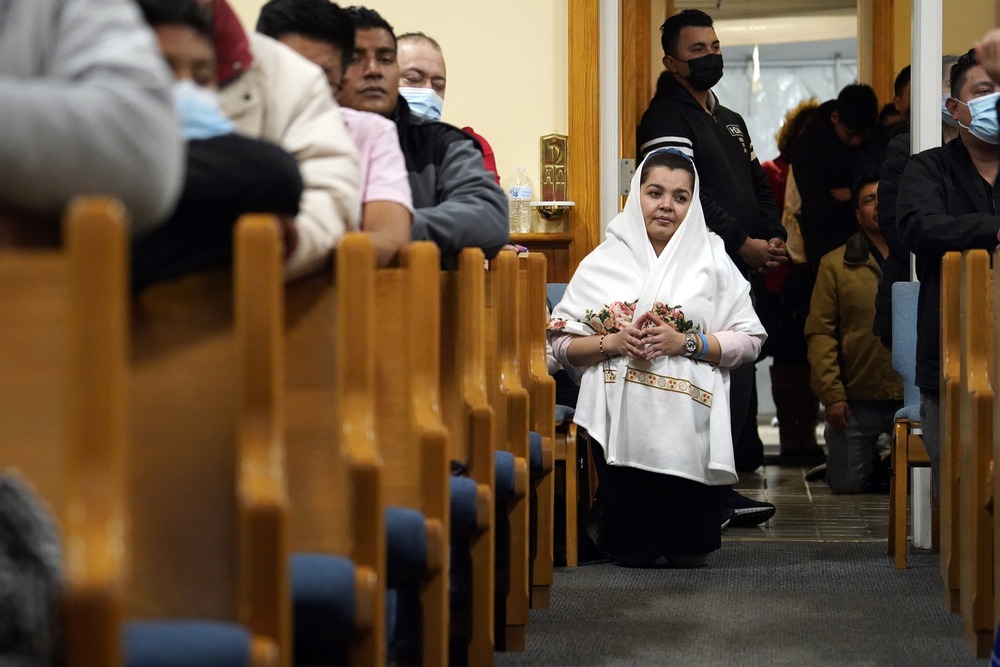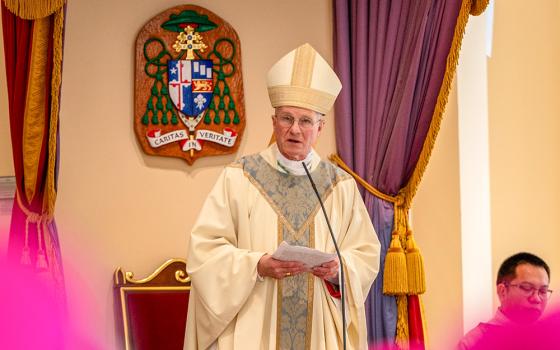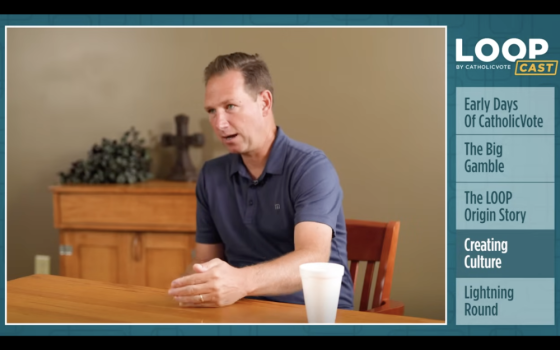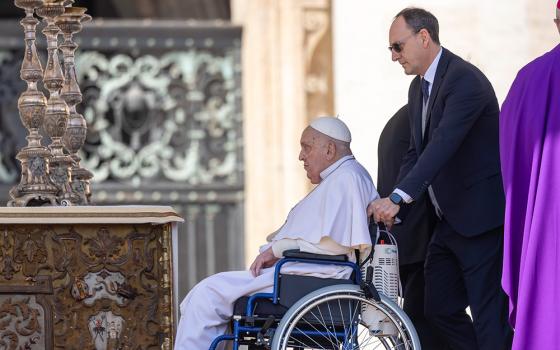
A woman kneels in an aisle while attending a Spanish-language Mass marking the feast of Our Lady of Guadalupe at Resurrection Church in Farmingville, N.Y., Dec. 12, 2021. Our Lady of Guadalupe is the patroness of Mexico, the Americas and the unborn. Eighty percent of Resurrection's parishioners are people of Mexican ancestry. (OSV News/Gregory A. Shemitz)
The U.S. bishops' Subcommittee on Hispanic Affairs conducted a survey of dioceses and archdioceses in the country's 14 episcopal regions and released its results Aug. 21. The survey shows how Hispanic ministry has taken off across the country and that in most dioceses, there is a parish-based pastoral response to Hispanic Catholics.
Alejandro Aguilera-Titus, assistant director of Hispanic Affairs under the Secretariat for Cultural Diversity in the Church at the U.S. Conference of Catholic Bishops, explained that the subcommittee sought to determine a baseline about the state of Hispanic ministry at the parish level.
He told OSV News that it was important to observe the implementation of the National Pastoral Plan for Hispanic/Latino Ministry, a 10-year plan that was approved by the U.S. bishops in June 2023, and "to see how that parish ministry will develop in the years ahead."
The survey, which was conducted from last April through July, included questions on the number of parishes in each diocese, the number of parishes offering Mass in Spanish, and the number of parishes with a Hispanic/Latino presence or ministry without a Mass celebrated in Spanish.
"It was very important to know what the starting point is, what is the number of parishes that already have a Sunday Mass in Spanish, which is the quintessential sign that we see that the Hispanic community has been welcomed as a community in a parish," said Aguilera-Titus. "In communities where the Spanish Mass is already established, many other ministries emerge as well."
He said the committee was pleased to find that almost 30% of the parishes in the country have a Sunday Mass in Spanish established.
An Aug. 21 press release from USCCB indicated that 175 surveys were completed, representing 100% of the Latin Catholic archdioceses and dioceses in the U.S. The survey results showed that 4,479 out of 16,279 U.S. parishes offered Sunday Mass in Spanish.
The survey also found that about 2,760 parishes have a Hispanic/Latino presence or ministry but do not currently offer Mass in Spanish and that "99% of the dioceses surveyed have several parishes that offer Mass in Spanish," according to the release.
"We are talking about the fact that there is a Hispanic presence throughout the country, in the 175 dioceses (of the Latin Church) in the country" and that in most of those dioceses, "there is a significant response or parish ministry," said Aguilera-Titus.
This survey focused on examining parishes serving Hispanics/Latinos in U.S. dioceses, but it also clarified that "several dioceses reported having missions or ministries serving Hispanics/Latinos extraordinary ministries or locations that are not identified as parishes" and that the survey did not intend to diminish those efforts.
Aguilera-Titus explained that in 2016-2017, a survey that was part of the V Encuentro process showed that about 4,485 parishes had some type of Hispanic ministry, although it did not specify data on Sunday Mass in Spanish, but rather Masses during the week or monthly masses. This new survey indicates that 4,479 parishes have Sunday Mass in Spanish and that, in addition, almost 3,000 parishes have some type of Hispanic ministry or presence but do not have a Sunday Mass in Spanish.
"We are talking about the significant growth in the response that the church is giving at the parish level," Aguilera-Titus said.
Over 42% of U.S. Catholics self-identified as Hispanic and it has been reported that this is the case for more than half of all U.S. Catholics under 30. But even though Latino Catholics have accounted for much of the growth of the U.S. church for decades, the data shows these Catholics are also leaving the church at high rates and becoming religiously unaffiliated, according to a 2023 report by the Pew Research Center.
"Much progress has been made in the awareness of the Hispanic presence in the country and in the response at the parish level," Aguilera-Titus said, but the subcommittee's survey also shows "that there are still thousands of parishes where that Hispanic presence needs to be more accurately recognized, and an adequate pastoral response needs to be given to that presence."
Aguilera-Titus anticipated that, in the context of the new pastoral plan for Hispanic ministry and its implementation, the number of parishes with Sunday Mass in Spanish and "with developed and well-organized ministries" will grow over the years.
Advertisement
Bishop Oscar Cantú of San Jose, California, chair of the Subcommittee on Hispanic Affairs, welcomed the results and said these types of surveys are vital to the church's response to Hispanic/Latino communities.
"There are common obstacles that dioceses face when engaging in Hispanic/Latino ministry, such as bilingual priests or limited resources," the bishop said, according to the USCCB press release. "This survey helps to measure our work and determine how we can continue serving this thriving part of our Church and the importance of ongoing ministry to the needs of our Spanish-speaking brothers and sisters."
Aguilera-Titus echoed the crucial need to promote more vocations to the priesthood and religious life among Hispanic Catholics. He added that it was important that, regardless of culture and origin, seminarians and priests, "especially pastors, who are not yet interculturally capable, acquire that intercultural capacity," knowledge, attitudes and skills "that will allow them to effectively and joyfully pastor with that Hispanic/Latino people that continues to grow in practically every corner of the country."
He also told OSV News that despite the financial challenges facing the church in the U.S., particularly dioceses, Hispanic ministry at the diocesan level continues to be very strong. "It's really good news that 57 of the dioceses that responded (to the survey) have their Hispanic pastoral office and director," he said.
The survey indicated that 47% of respondents were directors or coordinators of Hispanic/Latino ministry. Meanwhile, another 35% held positions in offices dedicated to cultural diversity, faith formation and catechesis. According to the subcommittee, this point shows the correlation of a robust diocesan structure and a vibrant ministry at the parish level.
Aguilera-Titus also commented on places where there was a need for further growth. "We also have about 20% of the dioceses where we see that the diocesan structure could be further strengthened to support Hispanic ministry. That was also included in the pastoral plan," he said.
Aguilera-Titus explained that three characteristics determine a successful diocesan ministry of Hispanic ministry (also known as "pastoral hispana"): the person who coordinates it has direct contact with the diocesan bishop, a budget that allows for the development of specific programs to support and promote and develop Hispanic ministry, and collaboration with other diocesan offices.
"We are deeply grateful for the high participation from the dioceses starting with the people who coordinate and direct Hispanic ministry, but also in some cases with people who were learning more about the Hispanic presence in their dioceses," Aguilera-Titus said.
The USCCB press release stated that the Diocese of Marquette, Michigan, did not participate in the survey and that the U.S. Archdiocese for the Military Services, the Diocese of St. Thomas in the Virgin Islands, the Personal Ordinariate of the Chair of St. Peter, and the Eastern Catholic archeparchies and eparchies in the U.S. were also not included in this survey.



